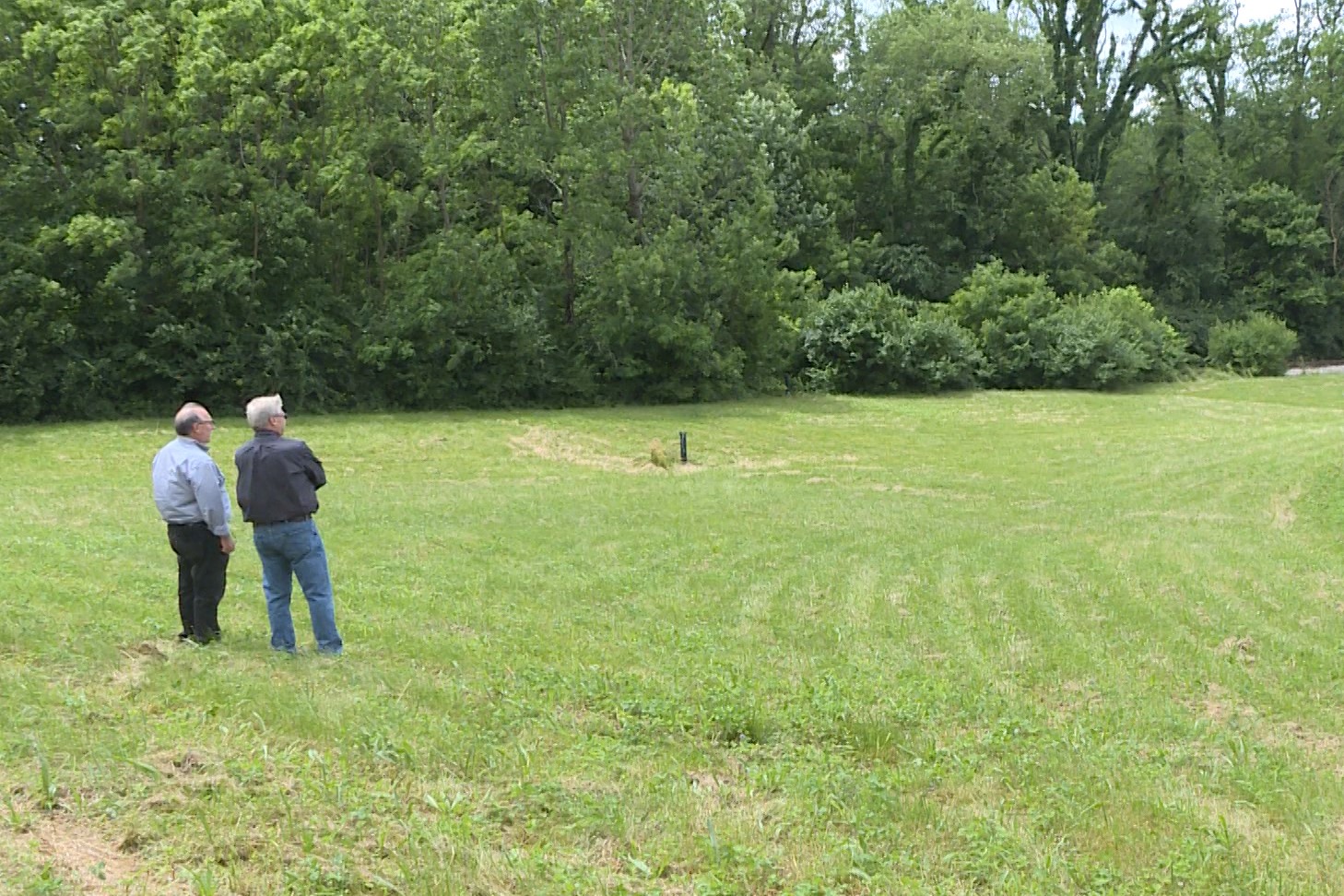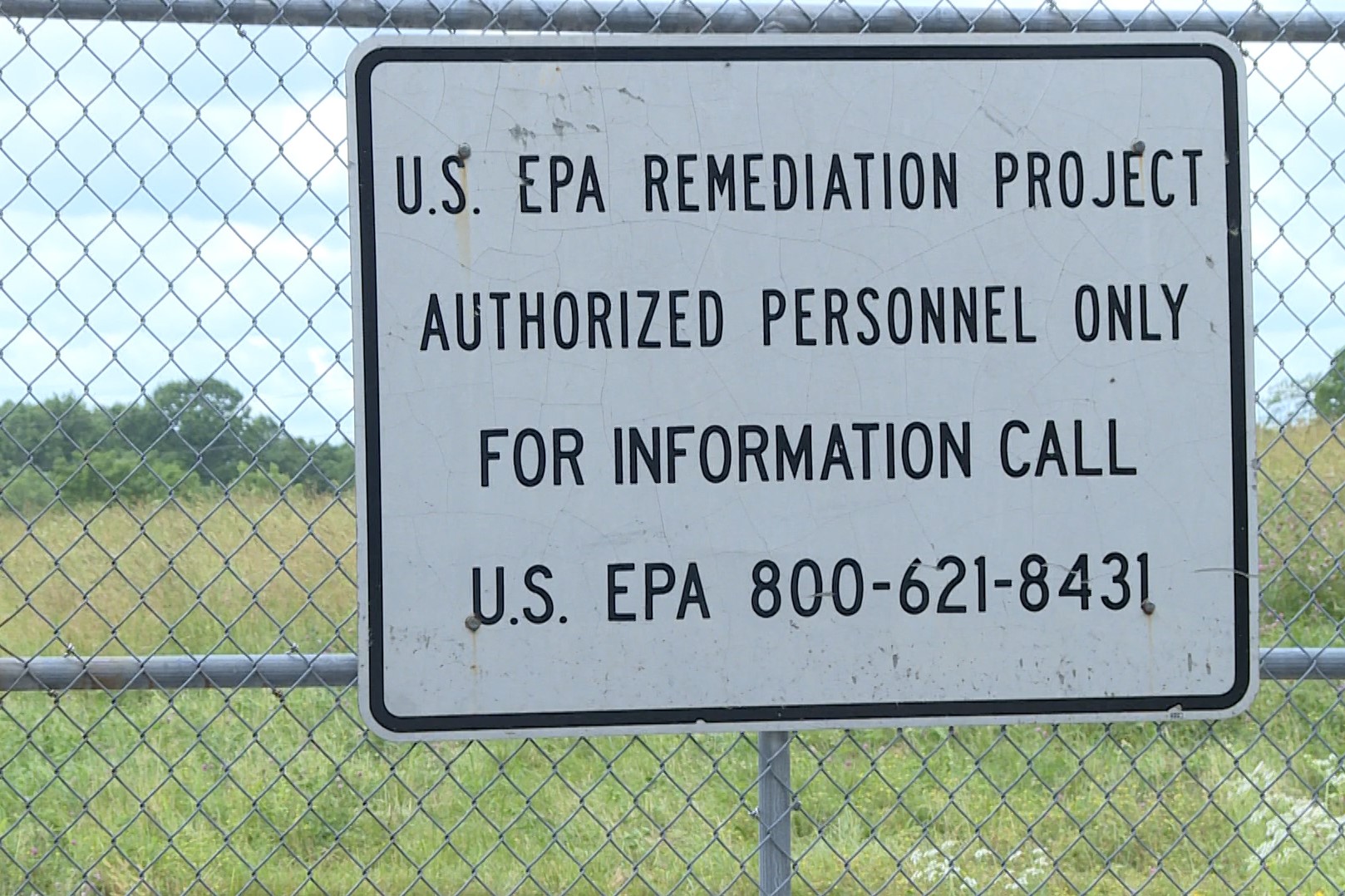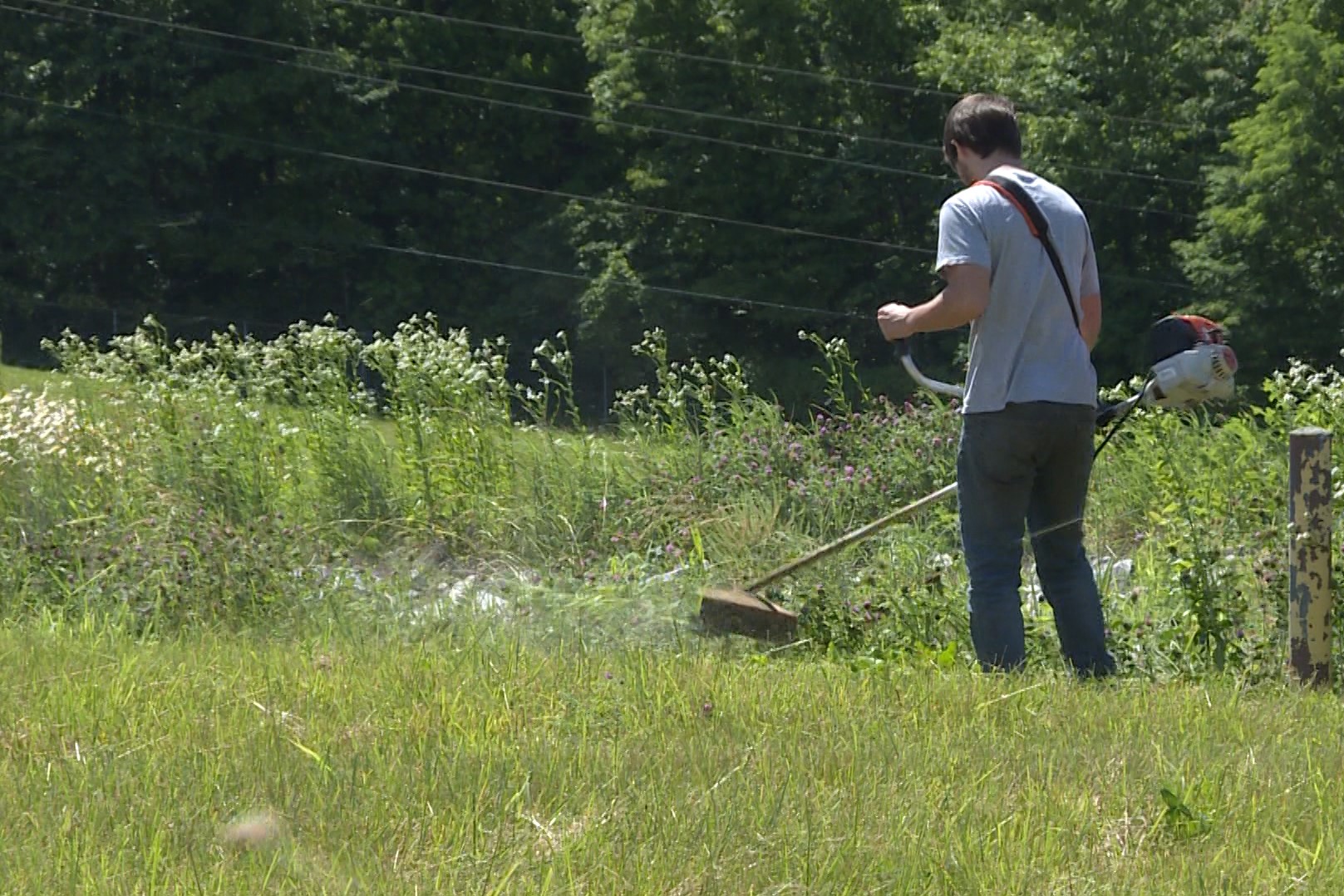
PCB cleanup at the Lemon Lane site in Bloomington. (Courtesy photo)
Editorial Note: This story was originally published in June, but City Limits readers continue to ask about the history and current status of PCBs in Bloomington.
Pollution from PCBs – short for polychlorinated biphenyls - has plagued the Monroe County area since the 1950s. A lot of cleanup has been completed, but the U.S. Environmental Protection Agency continues to list three toxic waste sites in Monroe County on the Superfund National Priorities List.
The three sites are part of a six-site cleanup the EPA ordered in 1984. Local, state and federal government agencies and Westinghouse signed a settlement called a Consent Decree in August 1985.
Only one of the other three sites from the 1984 order was deemed a Superfund site and it has been taken off the National Priorities List.
Jim Seaver of Bloomington asked WFIU about the contaminated sites.
“I’ve heard people kind of say, oh, out in the county there are some sites where things were dumped and things have been cleaned up a little bit but I never really knew the back story,” he says. “I never really knew what their status is today and whether they are a threat to people living here in Bloomington and the surrounding area in the 21st Century.”
Tom Alcamo has been the EPA’s remedial project manager for the Bloomington area cleanup for about three decades. He says most of the cleanup has been completed.
“We’re in something we call the operation and maintenance phase,” he says. That involves monitoring and reporting and maintaining the sites. “There isn’t a walkaway kind of remedy here. … There’s a lot of work being done and I’m pleased to date with the progress.”
The History
The environmental problems started when the Bloomington Westinghouse Electric Corp. plant was using oil laced with PCBs in electrical devices called capacitors. The company disposed of the capacitors in area landfills and dumps and the oil contaminated other areas as well.
Discovery of the contamination in the mid-1970s ignited a debate about what to do to ensure the public’s safety from PCBs, which are known to cause cancer in lab animals and the EPA classifies as a “probable human carcinogen.” In 1977 the compound was banned for use in manufacturing.
Nearly a decade of discussion resulted in the multi-jurisdictional federal legal document being signed in December of 1984 requiring the cleanup of Neal’s Landfill, Bennett’s Dump, the city’s Lemon Lane Landfill, the Anderson Road Landfill and the city’s Winston Thomas Sewage Treatment Plant in Monroe County, and Neal’s Dump in Owen County.
In 1985, John Langley was an administrator in Bloomington Mayor Tomi Allison’s office when he was named the city’s PCB Coordinator. He held the position until he retired last July.

He said besides the potential health risks, the question of who would be responsible for paying for the cleanup was a massive issue.
“The city had a potential liability under the Superfund law of being responsible to pay for the cleanup,” he said. “We estimated the cleanup to be somewhere between $100 million and $150 million.” That was four to six times the total civil city budget at that time.
A federal court determined Westinghouse, which eventually was purchased by CBS Corp., would pay for the cleanup.
“The interesting thing about Bloomington is there are a number of sites but there’s really only one responsible party,” says Alcamo. “That’s somewhat unique when it comes to other Superfund sites. But when you take all the work that’s been done to date … I would expect CBS has spent well in excess of $250 million on these sites. …”
The area sites are significant on the national map.
“It’s one of the larger sites but you have to understand there are multiple sites here,” Alcamo said. “So for example if you took Lemon Lane, there are many sites as big as Lemon Lane but there’s nothing in our region or that I’m aware of around the country where you see such a large group of sites with one responsible party and all the work that’s been spread out over such a large area.”
The Consent Decree originally called for an incinerator to be built south of Bloomington to destroy contaminated materials. But that idea faced severe backlash from the community and was dropped.
“It was very, very controversial,” Langley says. “It was a tumultuous time.”
Protesters descended on city council meetings. A slate of candidates filed to run in the 1987 city election on a platform opposing the federally-ordered incinerator plan before the outcry caused the plan to burn the waste to be scrapped.
Other cleanup methods that involved removal of materials began. The two smallest sites, Anderson Road Landfill and the Winston Thomas plant, have been cleaned up. The other four sites were listed on the Superfund NPL because of their extreme toxicity, large size, and potential for exposing the public.
Neal’s Dump near Spencer has been removed from the list in 1999, according to records provided by the EPA. Langley says the biggest concern about that site was its proximity to the White River.

That leaves three sites where cleanup tasks and monitoring continue more than three decades after it was ordered. Here is a brief history of the sites, and where the EPA says the cleanup stands:
Lemon Lane Landfill
The Lemon Lane Landfill covers nearly 10 acres on Bloomington’s west side. The EPA says from 1958 until 1964 a large number of electrical capacitors linked to Westinghouse were dumped there. Metal scavengers broke open the capacitors to reclaim metals, and the PCB-laden oil ran out into the ground.
Langley says when he first went to the site he saw “a wall of capacitors 12 to 15 feet high on one side of the landfill.” Making matters much worse was the location of the landfill.
“Lemon Lane is probably, geologically speaking, one of the worst places you can site a landfill because it had a groundwater conduit under it,” Langley said. PCBs leaking from the capacitors were getting into the groundwater.
The site has been cleaned mainly by removing “hot spots” of contaminated soil and capacitor parts for offsite disposal and capping the landfill with a synthetic liner. How hot? Langley said while the landfill has been cleaned to no more than 50 parts per million of PCBs, readings as high of 59,000 parts per million were registered in some surface samples when the cleanup began.
A visit to the site last week revealed a fenced-in, grassy area along a railroad track to the south, within view of I-69 to the west, and bordered by neighborhoods. The grasses are growing atop several feet of clean dirt on top of the federally approved synthetic cap.
The second remedy was construction of the Illinois Central Spring water treatment plant to treat contaminated groundwater and surface water that could escape the site.
Westinghouse was purchased by Viacom which was bought by CBS Corp. CBS is required to continue to operate the plant, which treats water flowing from the site. More than 2.2 billion gallons have been treated since the plant opened. CBS is required to sample the water and provide monthly and quarterly inspections of the landfill.
Neal’s Landfill
Neal’s Landfill is an 18-acre site three miles west of Bloomington that accepted industrial and municipal waste from 1949 until 1972. Westinghouse dumped electrical equipment including capacitors at the site from 1962 until 1970. People also scavenged for metals inside the capacitors at the site, adding to the problems. The site is located in karst topography and drainage contaminated a number of springs and two streams close to the site with PCBs, which were found in the water and fish in the streams.
About 5,000 tons of stream bed sediments and stream bank materials were excavated from Conard’s Branch and Richland Creek near the site. CBS was required to construct a water treatment plant at the site, and Alcamo said it has treated about 3 billion gallons of water.

More than 41,000 tons of contaminated materials was transported to a hazardous waste disposal facility in Michigan. More than 4,100 capacitors were removed.
The area now looks like a rolling pasture covered by grasses. A federally approved cap covers the primary landfill area and is covered by three feet of clay, then three feet of fill dirt. The area has been fenced and access is restricted.
CBS is responsible for long-term monitoring that includes monthly and quarterly discharge sampling and inspections. EPA is reviewing fish tissue results as part of the monitoring plan. That review is expected to be finished in July.
Bennett’s Dump
Bennett’s Dump is a four-acre site northwest of Bloomington. It’s a former limestone quarry that was filled in with various waste materials, including electrical waste including capacitors contaminated with PCBS. EPA says immediate actions to protect human health and the environment have been taken as long-term cleanup work continues. More than 36,000 tons of PCB-contaminated material was dug up from the dump and disposed of offsite. More than 1,700 capacitors were removed. CBS continues to operate a water treatment plant and passive quarry drain at the site and monitors samples on a quarterly basis.
Two entrances to the secluded site are blocked by gates and no-trespassing signs.
Fish tissue sampling from a creek associated with the Bennett’s Dump cleanup also is expected to be summarized this summer. Langley says fish tissue results both there and from near Neal’s Landfill will be one important indication of how successful the efforts have been. Alcamo said the results will determine if any additional remedies are needed at this time. He said preliminary results looked good.
How clean?
The most likely serious health effects in Monroe County from PCBs involve people who worked with the chemical compound at Westinghouse in the 1950s, ‘60s and ‘70s. A federal study released in 2006 found workers exposed to PCBs at the Bloomington factory were more likely than the general population to die from brain cancer and melanoma.
Other studies have linked lesser health effects to environmental exposure, though it’s difficult to determine how serious those effects have been in this area.
Langley is confident in the cleanup efforts but cautious about declaring an “all clear.”
“They’re still working at the Bennett site and that story will be told,” he said. “Lemon Lane I believe is effectively severed from leaking into the environment. I believe the control measures at the Winston Thomas plant were effective.”
He says PCB contamination has been “nondetectable for a long time” in stream sampling and he’s waiting to hear about the fish tissue results.
CBS declined our request for an interview, but Alcamo says CBS is doing everything required of it and the Superfund sites could be taken off the Superfund National Priorities List as soon as 2021. But that doesn’t mean the work is finished.
“CBS has implemented all the work that they agreed to,” he said. “That doesn’t mean that when you delist the site … that’s its walkaway. They still have all the legal requirements and we have the ability to reopen the remedies. It just means the company has met all the requirements of the construction and they’re doing operation and maintenance in accordance with the plan.”
Delisting, Alcamo said, “is just a way that shows progress to the rest of the country that these sites have been addressed. But we’re in the operation and maintenance phase of the project and I would expect the water treatment plants to operate for many, many, many years.”
Jim Seaver, who asked about the Superfund sites, says he feels relatively safe from PCBs but wants people to realize environmental mistakes can have long-lasting effects.
“One of the downsides of Bloomington’s history is that we are still atoning for some of the mistakes made by previous generations presumably with the best of intentions,” he said. “But it was a different time and standards of what was considered safe were very different and just because somebody put something in the ground back then doesn’t mean it isn’t still a threat to us now.”
That’s why federal environmental officials will continue to monitor the threat at those three Superfund sites well into the future, the result of a 35-year-old agreement to address contamination that began more than 60 years ago.
Have a question? Ask City Limits:
Our community is changing, from closing businesses to traffic and road construction to affordable housing, and we see the impact of these changes all around us.
We want to know: What questions do you have about how the Bloomington of tomorrow will impact your work, your personal life, your community and your future?
Here’s how it works: You submit a question you’d like us to explore about how Bloomington has changed over the past few decades, what you want to see for the city in the future and how ties with IU continue to shape the community.
So: What do you wonder about how Bloomington is changing and how it impacts your life?
Interested in an ongoing conversation how Bloomington is changing? Join our Facebook group!










